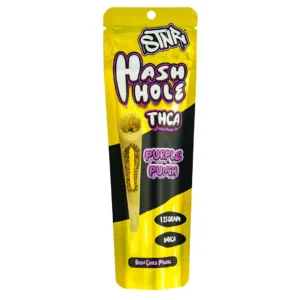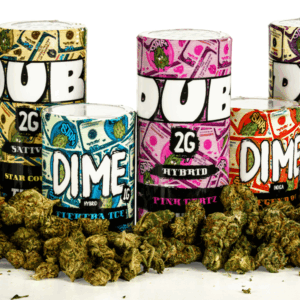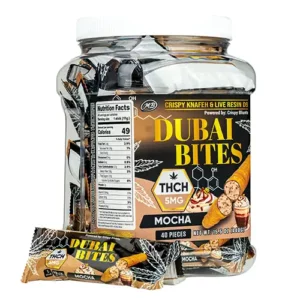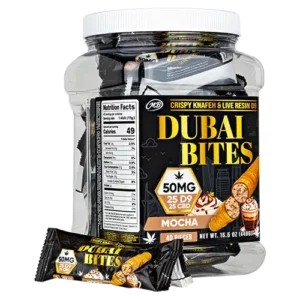THC-P, short for tetrahydrocannabipipiridine, is a lesser-known cannabinoid that is currently being studied for its potential therapeutic benefits. Research suggests that THC-P may have a stronger binding affinity to cannabinoid receptors than other cannabinoids, making it a promising candidate for providing relief from painful conditions and possibly other medical uses. Ongoing studies are looking into its potential to enhance the effects of other cannabinoids in different products.
However, as with any cannabinoid, there are also potential health risks associated with the consumption of THC-P that are being closely monitored. It’s important to continue researching and understanding its medical uses and potential risks before widespread use in products.
In conclusion, THC-P shows promise for its potential therapeutic benefits and possible uses in different products to enhance the effects of other cannabinoids. Ongoing studies and research in this area will continue to provide more insights into its medical uses and health risks.
Tetrahydrocannabiphorol
Tetrahydrocannabiphorol (THC-P) is a newly discovered cannabinoid that is known for its high potency. It is structurally similar to THC, the psychoactive compound found in cannabis, but is believed to be even more potent. As of now, there is limited research on THC-P and its effects on the human body.
THC-P is currently not explicitly listed as a controlled substance under federal law. Its legality at the federal level falls under the 2018 Farm Bill, which legalizes hemp and its derivatives, including cannabinoids, as long as they contain no more than 0.3% THC. However, it’s important to note that THC-P’s legal status can vary from state to state. Some states might have specific laws regarding THC-P and its use, so it’s important to be aware of the regulations in your area.
Given its potency and relatively recent discovery, THC-P is still a relatively unknown and unregulated compound. As the research on THC-P continues to develop, it’s likely that more information regarding its federal and state-specific legality will become available.
Chemical Composition
HHC, THC, THCP, and THC-O are all compounds that interact with the endocannabinoid system in the human body. Each compound has a distinct chemical composition and structure. THCP (tetrahydrocannabiphorol) is a recently discovered phytocannabinoid that is structurally similar to THC but with a longer alkyl side chain. THC-O (THC acetate) is a synthetic derivative of THC that also interacts with the endocannabinoid system.

The specific chemical makeup of each compound determines its unique properties and interactions with the endocannabinoid system. Differences in carbon bonds and alkyl side chains contribute to these variations.
Understanding the chemical compositions and structures of these compounds helps researchers comprehend how they interact with the endocannabinoid system and potentially provide therapeutic benefits. Continued research will shed more light on t
Hemp-Derived THC-P Explained
THC-P, or Delta-9-Tetrahydrocannabiphorol, is a relatively new cannabinoid that has garnered attention in the cannabis industry. It is derived from both hemp and marijuana plants, with minimal presence in both. Hemp-derived THC-P is created through a semi-synthetic process in labs, using CBD extracted from hemp as a starting point.
The natural THC cannabinoid isomer serves as a foundation for creating THC-P, with alterations made in the lab to convert it into the new compound. Despite its minimal presence in both hemp and marijuana plants, THC-P has been of interest due to its reported potency and unique effects.
Overall, the process of creating THC-P involves utilizing organic compounds found in hemp and marijuana plants and manipulating them into a new cannabinoid through semi-synthetic methods. As research and experimentation in the cannabis industry continue to evolve, the development of new cannabinoids like THC-P showcases the potential for expanding the range of products and experiences available to consumers.
Accessibility and Availability
Hemp-derived THC-P, also known as Delta-8-THC, has gained popularity for its milder psychoactive effects compared to traditional THC. The legality of THC-P varies as it is subject to both state and federal regulations. While some states have explicitly banned the sale and production of THC-P, others have allowed its use within certain parameters. This varying regulatory landscape has led to differing accessibility and availability of THC-P depending on where you are located.
Potential bans on hemp-derived THC-P could have a significant impact on its production and distribution. Restrictions would limit the availability of the product, potentially driving up prices and decreasing consumer accessibility. Additionally, restrictions could hinder research and development efforts aimed at producing THC-P, potentially stifling the growth of this emerging market.
The accessibility and availability of hemp-derived THC-P is currently impacted by the patchwork of state and federal regulations. Potential bans on THC-P could further limit its production and distribution, affecting both consumers and businesses in the industry.
Check out our other Cannabinoid Blog Posts
Cannabinoid Blog Posts
- Does Delta 8 Get You High: The Ultimate Guide
- THC-A vs THC: What’s the Difference and How Do They Compare?
- The Ultimate Guide To THC Lean: Everything You Need to Know
Research and Understanding
THC-P, short for tetrahydrocannabiphorol, is a relatively new and lesser-known cannabinoid that has been gaining attention in the research community. This compound was first identified in 2020 by a group of researchers studying the chemical makeup of cannabis plants.
Recent animal studies have shown that THC-P may have potential effects on pain and sleep, although further research is needed to fully understand its impact on human health. Its documented effects on pain and sleep in animals have sparked interest in its potential use as a therapeutic agent.
One potential concern with THC-P is its potential implications for drug tests. As a close relative of THC, the main psychoactive component of cannabis, THC-P has the potential to trigger a positive result for THC in drug tests. The detection window for THC-P in drug tests may vary depending on the type of test used, which could lead to confusion and false positives.
Overall, while THC-P shows promise in the realm of cannabinoid research, it also presents challenges in terms of accurate drug testing and potential misunderstandings regarding its effects. Further research and understanding of this compound are necessary to fully grasp its implications for human health and drug testing.
2 Gram THC-P Disposable
Premium THC-P Experience Immerse yourself in the exceptional potency of STNR Creation’s 2 Gram THC-P
Rated 4.00 out of 5
$32.99
What’s the Difference Between THC-P and Other THC Compounds?
THC-P, or tetrahydrocannabiphorol, is a lesser-known cannabinoid found in cannabis that is gaining attention for its potentially unique effects. When comparing THC-P to other THC compounds such as delta-9-THC and delta-8-THC, there are some key differences to consider. Let’s take a closer look at what sets THC-P apart from other THC compounds and its potential implications for cannabis users and the industry.
Delta 8 THC vs THCP
Delta 8 THC and THC-P are two cannabinoids with distinct chemical structures and cannabimimetic properties, leading to different effects and potency levels. Delta 8 THC is a well-known cannabinoid with a shorter carbon chain, resulting in milder effects compared to THCP. On the other hand, THCP’s longer carbon chain has been found to make it more potent and have stronger effects than Delta-8 THC.
When it comes to consumer experiences, Delta 8 THC is often reported to provide a more subtle and less intense high, while THCP is said to have a greater impact and more intense psychoactive effects. Due to these differences, individuals looking for a milder experience may opt for Delta 8 THC, while those seeking a stronger effect may prefer THCP.
In conclusion, the comparison of Delta-8 THC and THCP reveals the significance of their chemical structures and cannabimimetic properties in determining their potency and effects. Understanding these differences can help consumers make informed choices based on their preferences and desired experiences.
Delta 9 THC vs THCP
Delta 9 THC and THCP are both cannabinoids found in cannabis, but they have distinct differences in their molecular structures, potency, and cannabimimetic properties.
Delta 9 THC has a well-known molecular structure with a chain length of 21 carbon atoms. It is known for its psychoactive effects, often associated with the “high” experienced when using cannabis. On the other hand, THC-P has a longer chain length, consisting of 7 carbon atoms more than Delta 9 THC. This longer chain length is thought to contribute to its increased potency compared to Delta 9 THC.
Additionally, THCP has been found to have stronger cannabimimetic properties than Delta-9 THC, meaning it has a greater ability to bind to cannabinoid receptors in the body. This may result in more pronounced effects when consumed.
In summary, while both Delta-9 THC and THCP are cannabinoids with similar origins, their differences in molecular structure, potency, and cannabimimetic properties set them apart in terms of their effects on the body.
THC-P vs. THC
THC-P, or tetrahydrocannabiphorol, is a lesser-known cannabinoid that is rumored to be significantly more potent than THC, the more commonly discussed psychoactive compound in cannabis. Due to its potency, THC-P is believed to potentially produce stronger psychoactive effects than THC, although further research is needed to fully understand its effects on the body.
Legally, THC-P falls into a grey area since it is not explicitly regulated in many regions. In contrast, THC is widely recognized as a controlled substance in many countries, making its possession and use illegal.
Both cannabinoids interact with the body’s endocannabinoid system, which plays a crucial role in regulating various physiological processes. This interaction can potentially impact the development of new cannabis products, as companies continue to explore different strains and formulations to maximize the desired effects for consumers.
As the understanding of cannabinoids continues to evolve, research into THC-P and its effects is ongoing. However, it is clear that both THC and THC-P have the potential to offer unique experiences for cannabis users, and their differences in potency and legal status should be considered when exploring their potential impacts.
READ: For more information on STNR Disposable vape’s check out our product review below.
Does THC-P get you high?
With the recent rise in popularity of THC-P, there has been much speculation about its effects and whether it can produce a high similar to that of THC. In this article, we will explore the research and evidence surrounding THC-P and its potential to induce a psychoactive high. Let’s take a closer look at this intriguing cannabinoid and what the science has to say about its intoxicating effects.
Is THC-P Stronger Than THC?
THC-P, also known as tetrahydrocannabiphorol, is a cannabinoid compound that has been gaining attention for its potential potency compared to THC, or tetrahydrocannabinol. While THC is well known for its psychoactive effects, THC-P is believed to have a higher affinity for cannabinoid receptors, potentially making it stronger in terms of its impact on the body.
However, it is important to note that the potency of THC-P is still being researched and understood. The relationship between THC-P and THC is complex, as both compounds interact with the endocannabinoid system in different ways. Additionally, individual tolerance and the overall complexity of cannabis intoxication play a significant role in how these compounds affect each person.
There is a common myth surrounding the potency of THC-P, but it is essential to approach this topic with a critical mindset. More research is needed to fully understand the differences between THC-P and THC, as well as their respective strengths and interactions with cannabinoid receptors. As always, it is crucial to approach cannabis use with caution and awareness of individual tolerance levels.
Is THC-P stronger than Delta 9?
Yes, THC-P has been reported to be stronger than Delta 9 THC. This is because THC-P has a higher affinity for both the CB1 and CB2 receptors in the endocannabinoid system. Additionally, the molecular structure of THC-P is slightly different from Delta 9 THC, which may contribute to its increased potency. Some studies have suggested that THC-P could be 5 to 10 times stronger than regular Delta-9 THC, leading to more intense psychoactive effects.
When comparing THC-P with Delta-8 THC, THC-P is also considered to be more potent. Delta-8 THC has a lower affinity for the CB1 and CB2 receptors compared to THC-P, resulting in less intense effects. Furthermore, users have reported that THC-P produces stronger and longer-lasting psychoactive effects compared to Delta 8 THC.
Overall, THC-P appears to be a promising cannabinoid with significantly increased potency compared to Delta-9 THC and Delta-8 THC. However, more research is needed to fully understand the effects and potential benefits of THC-P.
What Does the THC-P High Feel Like?
Many users report that the THC-P high brings a sense of relaxation and euphoria, leading to an improved mood and overall positive experience. The sensation can vary from person to person, with some experiencing a mild body high accompanied by increased energy, while others describe a mellow body high with warm, tingling sensations.
One of the key features of THC-P is its versatility in providing different and enjoyable effects, making it a popular choice for those seeking a sensible and pleasant high. The overall experience can be described as calming and uplifting, leaving users feeling both physically and mentally at ease.
Overall, the THC-P high is often described as a well-rounded and enjoyable experience, offering a range of effects to suit different preferences and moods.
How long does THC-P stay in your system?
THC-P, a newly discovered cannabinoid, can remain in the human body for up to 30 days due to various biochemical and physical factors. Like delta-9 THC, consistent use of THC-P can lead to prolonged detection in the system. Metabolism plays a significant role in the duration of THC-P in the body, with factors such as age, weight, and overall health impacting how quickly it is processed and eliminated. Additionally, the similarity of THC-P to delta-9 THC means that they both follow similar pathways of metabolism and elimination.
Because of these factors, small amounts of THC-P can linger in the body long after use. As research on THC-P is still limited, there is ongoing exploration into how individual differences in metabolism and consistent use can affect the duration of THC-P in the system. As with any substance, it’s important for individuals to be aware of how their body processes cannabinoids and to consider how their habits may impact the duration of THC-P in their system.
Will THC-P show up in a drug test?
THC-P, a newly discovered cannabinoid, has been making waves in the cannabis world due to its potential psychedelic and therapeutic effects. However, it’s important to be aware that THC-P may show up on drug tests due to its structural similarity to THC and the production of the same metabolite, THC-COOH, in the body.
This poses challenges in environments where cannabis consumption is restricted or regulated, as individuals using products containing THC-P may risk testing positive for THC on a drug test. Employers, law enforcement, and other organizations with drug testing requirements may need to consider the implications of this when implementing their policies.
It’s crucial for individuals to exercise caution when considering the use of THC-P products, especially if they are subject to drug testing requirements. While the potential benefits of THC-P are intriguing, users should be mindful of the potential consequences of testing positive for THC due to the presence of this cannabinoid in their system.
The Effects of THC-P
THC-P, also known as tetrahydrocannabiphorol, is a recently discovered cannabinoid that has been garnering attention for its potential effects on the body. With the growing popularity of cannabis products, researchers and consumers alike have become curious about the potential therapeutic and psychoactive properties of THC-P. In this article, we will explore the effects of THC-P on the body and its potential implications for medical and recreational use. Let’s dive into the science behind this novel cannabinoid and what researchers have uncovered so fa
Binding at CB1 and CB2 Receptors
The binding affinity of (-)-trans-Δ9-THCP against human CB1 and CB2 receptors was found to be high, with inhibition constants (K) of 1.2 nM and 6.2 nM, respectively, when using the Cheng Prusoff equation. The dose-response curves for (-)-trans-Δ9-THCP binding to purified human CB1 and CB2 receptors showed a high affinity, consistent with the low K values. For docking calculations, the X-ray structure of the active conformation of hCB1 receptor in complex with the agonist AM11542 was used as a reference, providing a rationale for the choice of structural model. These findings provide valuable insights into the specific binding properties of (-)-trans-Δ9-THCP at CB1 and CB2 receptors, which could have implications for understanding its potential therapeutic effects.
How long does THC-P last?
THC-P, a potent cannabinoid, can produce varying effects depending on the delivery method and user tolerance levels. When inhaled, the effects of THC-P typically peak within 10-30 minutes and last for 1-3 hours, with a gradual tapering off afterwards. On the other hand, edibles such as gummies or cookies can take longer to take effect, usually peaking within 1-2 hours and lasting for 4-6 hours or more. This delayed onset and extended duration of edibles can catch some users off guard, leading to potentially stronger and longer-lasting effects than anticipated. It’s important for users to be aware of their personal tolerance levels and to start with a low dose when consuming edibles. Overall, the duration of THC-P’s effects can vary significantly based on the delivery method and individual sensitivity, so it’s crucial to approach consumption with caution and mindfulness.
Risks and Side Effects
THCP is a newly discovered cannabinoid that has been found to have potent psychoactive properties. When consuming THCP, individuals may experience a high level of mental and physical impairment, which can lead to impaired decision-making and an increased risk of accidents or injuries. There is also a potential for psychological distress, including anxiety, paranoia, and hallucinations. It is important for individuals to be well-informed about the potential risks and side effects of THCP before consuming it. Consulting with a healthcare professional can provide guidance on whether THCP is a safe option based on an individual’s health and medical history. It is crucial to consider the potential impacts on mental and physical well-being before using THCP and to proceed with caution.
The Need for More Research
THCP, a newly discovered cannabinoid, has sparked great interest in the scientific community due to its potential potency and effects. However, there are currently significant gaps in research on THCP, including the lack of standardized dosing and long-term effects. Further scientific study is needed to better understand its potential benefits and risks.
The strength of THCP also raises potential implications, such as the possibility of more severe side effects and drug interactions compared to other cannabinoids. These implications highlight the importance of conducting thorough research on THCP before it can be safely and effectively used.
It’s worth noting that some countries strictly prohibit THC products, and regulators in Europe and Asia have reserved stances towards the substance. These factors contribute to the need for more research to establish the safety and efficacy of THCP.
In conclusion, there is a clear need for more comprehensive research on THCP to address the current gaps in knowledge, establish standardized dosing, and understand its potential implications. This will ultimately pave the way for informed decisions on the use of THCP in medical and recreational settings.
What Are the Benefits of THC-P?
THCp, or tetrahydrocannabiphorol, is a newly discovered cannabinoid that may offer a range of potential benefits. Some studies suggest that THCp may have stronger binding properties to cannabinoid receptors than THC, leading to potentially more potent physical and mental effects.
In terms of physical effects, THCp may offer pain relief and anti-inflammatory properties, making it a potential therapeutic option for conditions like arthritis or chronic pain. It may also have appetite-stimulating effects, which could be beneficial for individuals experiencing appetite loss due to medical conditions or treatments.
Mentally, THCp may provide a strong sense of euphoria and mental stimulation. This could potentially make it a promising option for individuals seeking relief from anxiety or depression, or for those looking for a mood boost.
As research on THCp is still in its early stages, it’s important to note that these potential benefits are based on limited studies and may vary from person to person. However, the discovery of THCp opens up new possibilities for understanding the effects of cannabinoids and their potential therapeutic applications.
References:
Tetrahydrocannabiphorol (THCP) is a naturally-occuring cannabinoid which is similar in structure to tetrahydrocannabinol (THC). The structural difference between THC and THCP lies in the pendant alkyl chain–THC has a 5-carbon tail, whereas THCP has a 7-carbon tail:
THCP was first discovered at the University of Modena and Reggio Emilia by Canazza and coworkers. These researchers isolated THCP from naturally occurring cannabis and measured the corresponding receptor binding affinities for this recently discovered molecule.1 Additionally, the cannabidiol equivalent CBDP has been found in hemp.
While the chemical structures are similar, there exists a significant difference between the binding affinity of THC and THCP to our CB1 receptors. In fact, THCP has a significantly stronger binding affinity than THC molecules. As with THC, both Δ8 and Δ9 isomers of THCP can be produced. The Δ8isomer has a binding affinity roughly twice as strong as Δ8 THC, providing more potent pain relief effects and allowing the user to obtain the desired effect from a smaller dose. Δ9 THCP, however, binds to our CB1 receptors roughly 33x as strong as Δ8 THC.
Citti, C., Linciano, P., Russo, F. et al. A novel phytocannabinoid isolated from Cannabis sativa L. with an in vivo cannabimimetic activity higher than Δ9-tetrahydrocannabinol: Δ9-Tetrahydrocannabiphorol. Sci Rep 9, 20335 (2019).
FAQs Unraveled
Got questions? We’ve got answers! Here’s a quick-fire round to clear up some common queries:
- Is THC-P natural? Yep, it’s as natural as THC, just rarer.
- Can THC-P show up on a drug test? It’s possible, especially given its relation to THC.
- How do you consume THC-P? Much like THC, it can be found in oils, edibles, and more. But tread lightly, given its potency.
Wrapping It Up: What’s Next for THC-P?
As we wind down our THC-P tale, it’s clear that we’re only scratching the surface. The potential of THC-P is vast, and as research deepens, we’re poised on the brink of exciting discoveries. Whether you’re a cannabis connoisseur or just cannabinoid-curious, THC-P is a term you might want to keep an eye on.
So, there you have it – a whirlwind tour of THC-P, its potency, possibilities, and the caution it demands. As we continue to navigate the ever-expanding world of cannabinoids, THC-P stands out as a potent reminder of the plant’s uncharted territories, waiting to be explored. Please check out our STNR Creations 2G THC-P Disposable.











